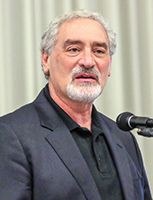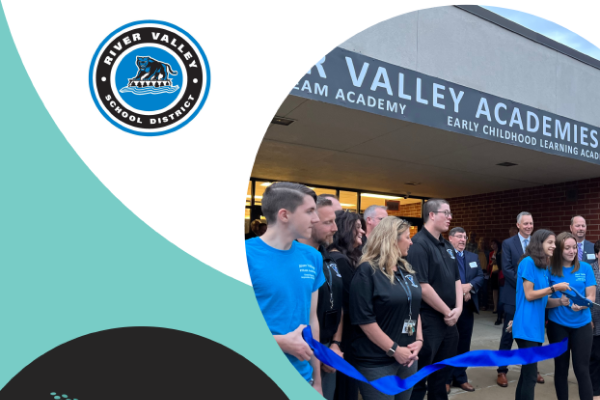Personalized Education on the Systems Level
November 01, 2015

The Falls Church, Va.,-based Inova Health System launched its Center for Personalized Health to much fanfare this year, which it says will “enable individuals to live longer, healthier lives.”
While the concept of personalized medicine,
which tailors health care to a patient’s individual characteristics and preferences, is gaining steam, so is personalized learning, which similarly customizes education to the individual student’s needs.
In fact, we’re hearing encouraging pronouncements from school districts across the country:
- Valerie Truesdale, chief of technology, personalization and engagement of Charlotte-Mecklenburg Schools in Charlotte, N.C., says her district empowers students to take ownership of their learning by providing them with multiple ways to demonstrate mastery learning in order to become successful 21st-century citizens.
- Ken Grover, principal of Innovations Early College High School in Salt Lake City, refers to “cultivating a personalized education for every student” and says, “… students are better served in this customized, self-directed learning environment that is rich with technology.”
- William Hite, superintendent in Philadelphia, describes personalization as “that which creates deep relationships so that students are well known to the adults in the school.” Personalization, he adds, is “at the core of forming new schools.”
Common Factors
Without changes at the system level, individual classroom improvement efforts will struggle to succeed. Consider the fictional English teacher Horace Smith in Ted Sizer’s Horace’s Compromise: The Dilemma of the American High School (1984). He was dedicated and knowledgeable but he found the standardized environment of schools diluted his efforts as he dealt with rushed classes, mindless tests and standardization from outside his school.
We want to create school systems where wonderful teachers, staff and administrators have the chance to succeed with their students.

Commonalities among the inspiring K-12 education models of personalization are these:
Adding meaning to student assessment with less reliance on standardized testing.
A personalized approach to assessment requires the school district to build consensus on what students should know, do and understand. Specifically, districts need agreement on what is truly worth learning. Schools must consider the intellectual dispositions and habits of mind of students, as well as the work competencies they will require as lifelong learners.
Personalized school systems also must consider goals related to students’ development beyond their academic and intellectual growth. How, for example, will we monitor students’ development of career competencies and access to emerging career pathways? How will every learner develop a commitment to lifelong habits of healthy nutrition and physical well-being? What data will we use to monitor students’ social and emotional development ?
A personalized curriculum requires each student to demonstrate higher-order reasoning skills. In a world history class, for example, learners will explore themes and patterns of historical interaction through various lenses, including political, economic and cultural historiography. This focus on conceptual depth of understanding results in better standardized test performance because learners internalize the content rather than mechanically retrieving it in isolated instances.
Maximizing the impact of technology and support resources to address the digital divide.
Personalized education requires an individualized education plan be developed for each student, not just those in special education. Technologies can make this daunting task feasible.
Using a blended approach, for example, the teacher can identify a subgroup of students whose formative assessments indicate they are at a similar point in the instructional continuum. The teacher can deliver a lesson to that subgroup, then have them engage in individual activities on their laptops to reinforce the lesson, assess the degree to which they have mastered the concept and provide additional activities for those students who need improvement. Each student proceeds at his or her own pace until mastery is reached and the teacher groups and regroups students based on the degree of mastery attained.
Using technology to profile students allows us to go beyond what the student knows and doesn’t know . From a student’s previous responses, instruction and a lesson plan can be tailored to the student’s interests, motivations, attention span, knowledge and skills.
Personalizing health, social and psychological services for students and their families.
Counselors, social workers and psychologists are invaluable partners in a personalized learning environment. Through increased classroom presence and interaction, they can work with instructors to help students feel emotionally supported and socially engaged. Personalization for students with challenges such as limited English proficiency or disabilities, may necessitate additional access to intervention services.
If the purpose of 21st-century personalized education is to prepare students for success in our ever-changing global environment, a holistic set of services should be accessible to them throughout their K-12 schooling. The common siloed approach to student services can be replaced with an organic, integrated design that allows teachers the time and ability to monitor student progress with social services professionals.
Postsecondary education and career preparation becomes a fundamental part of the curricula. All students will have individualized career and academic plans, beginning in the early grades. The plans will become part of students’ personal electronic portfolio, which allows instructional and social service personnel to monitor progress and provide appropriate acceleration, enhancements and interventions as needed.
Including parents and members of the community as partners.
Personalized individual learning plans aren’t simply sent home for parents’ signatures; they involve the parents every step of the way with parents understanding the learning plan and accepting their role in supporting their children. Many districts have created parent academies to support parents in learning languages or other literacies. Perhaps every school should have a parent academy.
Communities also must do their part to support the education of their children. Organizations may organize internship or shadowing programs to help students explore different pathways in a field of the child’s interest. For example, at City Arts and Technology High in San Francisco, juniors and seniors secure internships where they are mentored by an on-site professional and regularly visited by their school adviser. MetWest High School in Oakland, Calif., is one of many that place student internships at the center of their mission.
As we ask children to learn in new ways, with ever-increasing expectations, the reality that most children in public schools now live in poverty compels us to change the way we involve those who impact students most directly. Providing family connections to the learning, and looking at parents and neighborhoods as assets rather than blaming them for the students’ learning struggles will create greater opportunities for closing the opportunity gap and leading to student success.
Schooling’s Purpose
The question of what it means to truly prepare a student for the world of work in the 21st century — particularly in a perpetually tight job market — seems more complex than ever.
Is the primary purpose of schooling to narrowly prepare students to perform specific technical skills for specific, predetermined positions? This seems like a limiting and even potentially dangerous path to pursue. What about the idea that public education is intended to create literate, productive, participating citizens in order to sustain our democracy? Can’t we prepare students for work as well as a full, engaged life? Just as our comprehensive high schools and vocational schools need to personalize approaches to learning, so must they ask questions about the broad and inclusive purpose of education so that the knowledge and skills of this unfolding century serve as the guide.
The skills to enter the working world today differ vastly from previous generations. Like many others, my father never graduated from high school, earning a living working with his hands as a mechanic.
Despite his limited education, his advice
on this subject was deeply insightful: “You can choose to be a mechanic,” he told me, “but don’t let your bad choices make that decision for you.” Are we preparing our children to make such an active choice?
Today, entering the workforce no longer means just going out to the shops or the fields, getting your hands dirty. The skills, attitudes and base-knowledge needed to successfully navigate within the working world are very different. Mike Rose’s The Mind at Work: Valuing the Intelligence of the American Worker presents a view of the combination of cognitive and manual skills needed in occupations that our society has mistakenly devalued.
A Sweeping Reimagination
There are significant implications of personalized learning for administrators, board of education members and community leaders. Supporting the conditions that allow for personalized learning means not just adjusting schedules, but also looking at policies, grading practices, differentiated staffing, communication and even the structure of school facilities.
Design-based teaching promotes a new way of looking at student learning and teacher support. This pedagogy compliments what many see as the core to personalization: design based learning. Just as students construct, design, their learning paths, so do teachers collaborate as they design the teaching and resources necessary for student success. No more “If it’s Tuesday, we must be on page 72” mentality.
Educators must be flexible, engaged and absolutely committed to the success of every student. They must capitalize on the power of parent, community and cross-institutional partnerships to expand student access to a range of mentors.
New Opportunities
As educational leaders design new approaches to learning and teaching, the reality is that we have a good base on which to move ahead (e.g., graduation rates are the highest ever, according to the U.S. Department of Education). We also must be candid that with the majority of school-aged children now living in poverty, merely tinkering with schools just doesn’t cut it.
The major opportunity ahead of us is based on three essential questions I learned a long time ago:
- What are we going to teach?
- How are we going to teach it?
- How do we know if the students learned it?
These questions are certainly an oversimplication of the work of district and school leaders. The reimagination of schooling through the lens of personalization to help all students learn at the highest possible levels moves away from the Common Core debates and associated assessments to the heart of teaching and learning.
About the Author
A former superintendent, is associate executive director for leadership services and awards at AASA. E-mail: msherman@aasa.org. Twitter: @64msherman. This article is adapted from the author’s forthcoming book Personalizing 21st Century Education: A Framework for Student Success(Jossey-Bass), co-authored with Daniel Domenech, AASA executive director, and John L. Brown, director of curriculum for Alexandria, Va., Public Schools.
Advertisement
Advertisement
Advertisement
Advertisement



